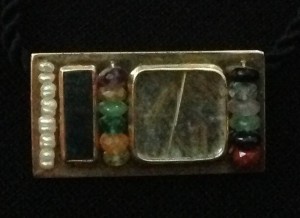Though one can find necklaces, pins, and bracelets featuring doves, angels, and fish, the overwhelming theme for Christian jewelry is the cross, configured or nested in a wide array of options. You find them in wood, silver, and jade, constructed of nails, imprinted on dog tags, and mounted sideways on leather wristbands.
I never paid Bible jewelry much attention, except to join others in bemoaning the way in which morally diffuse celebrities wore it prominently. But then, I preached through Revelation, where I became intrigued with the picture of heaven and its (likely figurative) precious stones in chapter 21, verses 18 to 21. I’d heard of jasper, sapphire, emerald, topaz, and amethyst, but what in the world were chalcedony, sardonyx, carnelian, chrysolite, beryl, chrysoprase, and jacinth?
 I did a cursory search, just enough to nail down pronunciation and get a rough sense of color. But I came back to the list on a visit to Chicago’s Field Museum, specifically its “Gems and Minerals” collection, where I think I found nine of the twelve. I can’t remember if it was an approaching anniversary or birthday, but I started to wonder if I might commission a jeweler to make something for my wife along these lines.
I did a cursory search, just enough to nail down pronunciation and get a rough sense of color. But I came back to the list on a visit to Chicago’s Field Museum, specifically its “Gems and Minerals” collection, where I think I found nine of the twelve. I can’t remember if it was an approaching anniversary or birthday, but I started to wonder if I might commission a jeweler to make something for my wife along these lines.
Sure enough, the resident designer at a local jewelry store picked right up on the idea. I was afraid that some of the names were anachronistic, out of fashion, but she assured me that they were all in circulation. She had the stones handy. So we began to talk about layout, including pearls for the gates, jasper for the walls, and gold/crystal for the streets, and settling finally on something like a military ribbon. (See photo.) To round things out, I had “To my heavenbound wife” inscribed on the back, along with the scriptural reference.
No surprisingly, my heavenbound wife used it to help others become heavenbound. Wearing it into the marketplace, she took advantage, upon request, to explain its meaning and point people toward salvation in Christ. While virtually no one asks the meaning of a cross around the neck (though, of course, few really understand the need for Calvary), a composition built around Revelation 21 was another matter. Which got me thinking. Given funds, priorities, and occasion, what might I turn to next?
Psalm 150 came to mind first. Maybe a jeweler could cluster trumpet, lyre, tambourine, flute, and cymbals. When asked, Sharon could talk about the joy she has in praising the Lord. Or what about a genealogy for Christ, say the one in Matthew 1? Perhaps it could feature an altar (Abraham and Isaac), a stairway or ladder (Jacob), stalks of wheat (Ruth and Boaz), a scroll (Josiah), a harp (David), and a manger (Jesus). The wearer could explain God’s sovereignty, providence, and mercy in preserving and advancing the lineage of the Messiah.
Or what about the closing greetings in Romans 16, where Paul honors the ordinary saints who make up the local fellowship? Using the root meanings of their names, we start with an eagle for Aquila, a head of grain for Stachys, and some amber for Rufus (“red haired”). With over two dozen cited, the combinations are endless (and best left to the aesthetically gifted). Conversations prompted by this piece would naturally start with the Body of Christ.
So yes, I got in touch with my feminine side for that gift, but I think I also got in touch with my biblical-imagery side, with an eye to witness as well as an eye to honoring my God-given, godly wife of over four decades. Which reminds me of Proverbs 31:10-31. I think someone could do something nice with a vineyard, a spindle, and a purple amethyst—with the added note that the wife is more precious than that amethyst or any other jewel, for that matter (31:10).
//